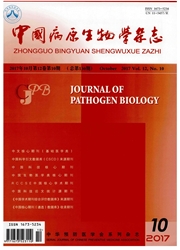

 中文摘要:
中文摘要:
目的研究旋毛虫蛋白酶体β7亚基(T.spiralis proteasome subunit beta type-7,Tspst)的基因功能。方法通过浸泡法将Tspst特异性的dsRNA(dsRNA-Tspst)导入旋毛虫肌幼虫体内,应用Real-time PCR和Western blot检测经dsRNA-Tspst浸泡处理后幼虫Tspst基因的转录和表达水平。体外培养观察Tspst基因沉默对幼虫存活的影响。将dsRNA浸泡后的幼虫经口接种小鼠,观察Tspst基因沉默对幼虫发育、存活及雌成虫生殖力的影响。结果Realtime PCR和Western blot检测显示,旋毛虫幼虫经40ng/μl dsRNA浸泡处理后Tspst基因的转录和表达分别下降71.87%和61.9%(P〈0.05)。dsRNA浸泡处理组、Lip2000和PBS对照组幼虫的死亡率分别是33.4%、35%和35.4%(χ2=0.118,P〉0.05)。将dsRNA浸泡的幼虫接种小鼠后6d,肠道成虫与35d肌幼虫的减虫率分别为26.51%和38.34%。dsRNA浸泡处理组、Lip2000和PBS对照组幼虫感染小鼠收集的雌虫体外培养72h新生幼虫产量分别是53.26±3.99、50.80±3.08和53.70±2.57条(P〉0.05)。结论 dsRNA可明显抑制Tspst基因的表达及幼虫在小鼠体内的发育和存活。
 英文摘要:
英文摘要:
Objective To observe the functioning of the proteasome subunit beta type-7 (Tspst) gene of Trichinella spiralis. Methods Tspst-speeific double-stranded RNA (dsRNA-Tspst) was delivered to larvae via immersion and in- cubation. Levels of transcription and expression of the Tspst gene from larvae that had been immersed in dsRNA-Tspst were respectively determined with real-time PCR and Western blotting. The death rate of larvae that had been immersed in dsRNA-Tspst was observed in in vitro cultures. Larvae were immersed in dsRNA-Tspst and then injected in mice, and larval development and the viability and fecundity of female adult worms were investigated. Results Real-time PCR in- dicated that the level of Tspst transcription was 0. 28±0.02 1 day after T. spiralis larvae were treated with dsRNA, 1.05±0.05 after they were treated with Lip2000, and 1.00..0.02 after they were treated with PBS (F=466. 935, P= 0. 000). Immersing T. spiralis larvae in 40 ng/μl of dsRNA-Tspst resulted in a 71.8% decrease in Tspst transcription compared to larvae treated with PBS (P〉0.01). Western blot analysis indicated that the level of Tspst expression was 0. 77±0.05 3 days after T. spira[is larvae were treated with dsRNA, 1.98±0.13 after they were treated with Lip2000, and 2.02±0.21 after they were treated with PBS (F= 178. 570, P=0. 000). The level of Tspst expression in larvae trea- ted with dsRNA decreased 61.9 % compared to larvae treated with PBS (P〉0.05). Larvae immersed in dsRNA-Tspst had a death rate of 33.4%0, those treated with Lip2000 had a death rate of 35.0%, and those treated with PBS had a death rate of 35.4% (x^2 =0. 118, P)0.05). Compared to the control mice treated with PBS, mice injected with larvae that had been immersed in dsRNA-Tspst had a 26.51% decrease in intestinal adult worms and a 38.34 % reduction in the muscle larval burden. Female adult worms were collected from mice and newborn larval production in vitro was deter- mined. Newborn larval production was 53.26--3.99 whe
 同期刊论文项目
同期刊论文项目
 同项目期刊论文
同项目期刊论文
 期刊信息
期刊信息
